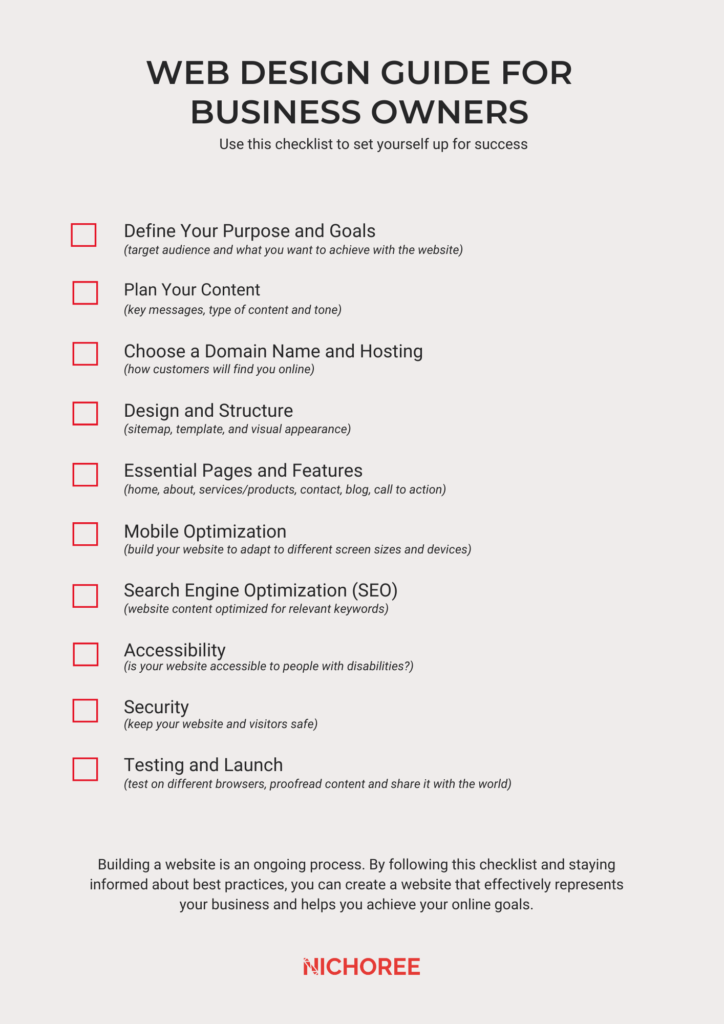How to Create a Website as a Business Owner
As a business owner your goal is to make sure that you set your business for growth. Putting your business online can seem intimidating and hard but in this digital era online presence for businesses has become crucial. There are several ways that you can bring your business online, in this article I will give you a simple guide on how you can create a website for your business. Whether you are taking on the task yourself or hiring someone help you build it, these steps can walk you through the process of creating a website for your business.
Download a summary of this web design guide and keep it for quick reference.
Web Design Checklist for Business Owners
1. Define Your Purpose and Goals
-
- What is the primary purpose of your website? (e.g., sell products, generate leads, provide information, build community)
-
- What specific goals do you want to achieve with your website? (e.g., increase brand awareness, drive online sales, generate leads, improve customer service)
-
- Who is your target audience? (e.g., demographics, interests, online behavior)
2. Plan Your Content
-
- What type of content will your website include? (e.g., product descriptions, blog posts, videos, testimonials, contact information)
-
- What key messages do you want to communicate?
-
- What is the overall tone and style of your content? (e.g., formal, informal, humorous, informative)
3. Choose a Domain Name and Hosting
-
- Select a domain name that is relevant to your business, easy to remember, and available. (e.g., www.yourbusinessname.com)
-
- Choose a web hosting provider that offers reliable service, security features, and adequate storage space.
4. Design and Structure
-
- Create a sitemap outlining the main pages and sections of your website.
-
- Choose a website design that is visually appealing, user-friendly, and reflects your brand identity.
-
- Consider using a website template or hiring a web designer to help with the design process.
5. Essential Pages and Features
-
- Homepage: This is the first page visitors will see. Make sure it’s clear, concise, and engaging.
-
- About Us: Tell your story, showcase your team, and build trust with potential customers.
-
- Products/Services: Describe your offerings in detail, including features, benefits, and pricing.
-
- Contact Us: Make it easy for visitors to get in touch with you. Include a contact form, email address, phone number, and social media links.
-
- Blog: Share valuable content, engage with your audience, and improve your search engine ranking.
-
- Call to Action: Include clear calls to action throughout your website, encouraging visitors to take the next step (e.g., make a purchase, contact you, sign up for your newsletter).
6. Mobile Optimization
-
- Ensure your website is responsive and adapts seamlessly to different screen sizes and devices.
-
- Test your website on various devices (smartphones, tablets, desktops) to ensure a consistent user experience.
7. Search Engine Optimization (SEO)
-
- Optimize your website’s content and structure for relevant keywords to improve your search engine ranking.
-
- Use descriptive page titles and meta descriptions.
-
- Build high-quality backlinks to your website.
8. Accessibility
-
- Ensure your website is accessible to people with disabilities.
-
- Use alt text for images, provide captions for videos, and ensure proper color contrast.
9. Security
-
- Install an SSL certificate to encrypt data transmitted between your website and visitors’ browsers.
-
- Use strong passwords and keep your website software updated.
-
- Consider using a web application firewall (WAF) to protect your website from attacks.
10. Testing and Launch
-
- Thoroughly test your website on different browsers and devices to ensure everything is working correctly.
-
- Proofread your content carefully for any errors.
-
- Once you’re happy with your website, launch it and start promoting it!
Remember:
-
- Start simple and focus on the essentials.
-
- Don’t be afraid to ask for help from web design professionals.
-
- Continuously update and improve your website based on user feedback and analytics.
Building a website is an ongoing process. By following this checklist and staying informed about best practices, you can create a website that effectively represents your business and helps you achieve your online goals.
Get your downloadable checklist summary and keep it handy for quick reference.

